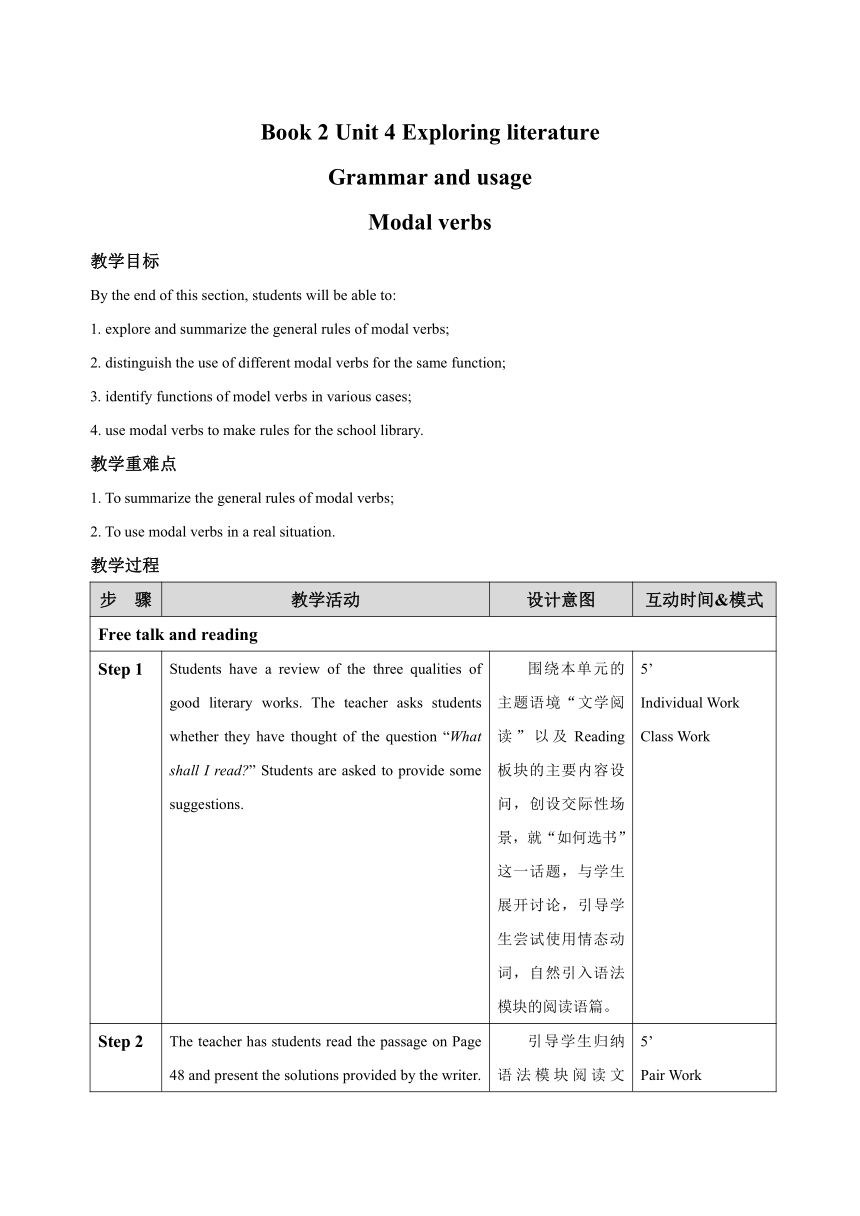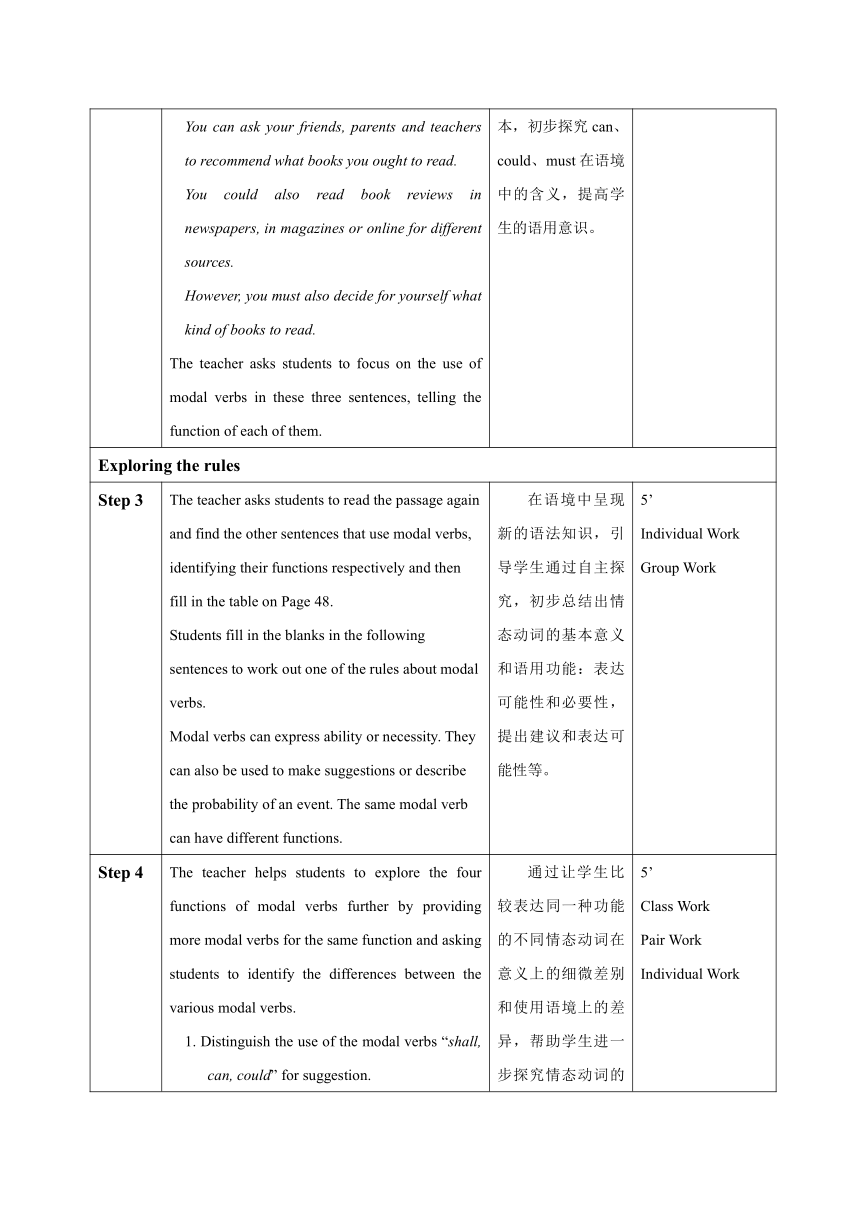牛津译林版(2019)必修 第二册 Unit4 Exploring literature Grammar and usage 教案(表格式)
文档属性
| 名称 | 牛津译林版(2019)必修 第二册 Unit4 Exploring literature Grammar and usage 教案(表格式) |  | |
| 格式 | docx | ||
| 文件大小 | 33.0KB | ||
| 资源类型 | 教案 | ||
| 版本资源 | 牛津译林版(2019) | ||
| 科目 | 英语 | ||
| 更新时间 | 2022-04-09 22:25:07 | ||
图片预览


文档简介
Book 2 Unit 4 Exploring literature
Grammar and usage
Modal verbs
教学目标
By the end of this section, students will be able to:
1. explore and summarize the general rules of modal verbs;
2. distinguish the use of different modal verbs for the same function;
3. identify functions of model verbs in various cases;
4. use modal verbs to make rules for the school library.
教学重难点
1. To summarize the general rules of modal verbs;
2. To use modal verbs in a real situation.
教学过程
步 骤 教学活动 设计意图 互动时间&模式
Free talk and reading
Step 1 Students have a review of the three qualities of good literary works. The teacher asks students whether they have thought of the question “What shall I read ” Students are asked to provide some suggestions. 围绕本单元的主题语境“文学阅读”以及Reading板块的主要内容设问,创设交际性场景,就“如何选书”这一话题,与学生展开讨论,引导学生尝试使用情态动词,自然引入语法模块的阅读语篇。 5’ Individual Work Class Work
Step 2 The teacher has students read the passage on Page 48 and present the solutions provided by the writer. You can ask your friends, parents and teachers to recommend what books you ought to read. You could also read book reviews in newspapers, in magazines or online for different sources. However, you must also decide for yourself what kind of books to read. The teacher asks students to focus on the use of modal verbs in these three sentences, telling the function of each of them. 引导学生归纳语法模块阅读文本,初步探究can、could、must在语境中的含义,提高学生的语用意识。 5’ Pair Work
Exploring the rules
Step 3 The teacher asks students to read the passage again and find the other sentences that use modal verbs, identifying their functions respectively and then fill in the table on Page 48. Students fill in the blanks in the following sentences to work out one of the rules about modal verbs. Modal verbs can express ability or necessity. They can also be used to make suggestions or describe the probability of an event. The same modal verb can have different functions. 在语境中呈现新的语法知识,引导学生通过自主探究,初步总结出情态动词的基本意义和语用功能:表达可能性和必要性,提出建议和表达可能性等。 5’ Individual Work Group Work
Step 4 The teacher helps students to explore the four functions of modal verbs further by providing more modal verbs for the same function and asking students to identify the differences between the various modal verbs. 1. Distinguish the use of the modal verbs “shall, can, could” for suggestion. 2. Distinguish the use of the modal verbs “can, could or be able to” for ability. 3. Distinguish the use of the modal verbs “should, ought to, must, have to” for necessity. 4. Distinguish the use of the modal verbs “may, might, could, must, can, should” for possibility. 通过让学生比较表达同一种功能的不同情态动词在意义上的细微差别和使用语境上的差异,帮助学生进一步探究情态动词的使用规则。 5’ Class Work Pair Work Individual Work
Step 5 Students explore the forms of verbs that can follow modal verbs by answering the question on Page 48. Modal verbs can be followed by “do, be done, be doing and have done”. The teacher asks students to tell the cases where different verb forms are used respectively. Students have a group discussion and come up with some examples for each of the forms. 让学生通过小组讨论,探究情态动词后所接动词的各种形式,自主创设使用不同形式动词的情境,提升归纳、总结的思维能力。 5’ Individual Work Pair Work
Step 6 Students go through Grammar notes on Pages 99–101. And later on, students raise their questions about this part. 在归纳总结出部分情态动词的使用规则之后,让学生自学课本后其他的规则作为补充。教师鼓励学生提出问题,激发其探究热情,培养自主学习能力。 5’ Pair Work Individual Work
Applying the rules
Step 7 1. The teacher asks students to turn to Page 49 and finish Parts B1 and B2. 2. The teacher asks students to tell the whole class about their choices and tell the reasons. As for Part B2, the teacher asks students to answer the following questions to have a better understanding of the modal verbs used in the passage. What did the writer think of reading Dickens’s A Christmas Carol at first How did it turn out What can we learn from the book, according to the author 通过句子、语篇两个层面的巩固练习,让学生内化情态动词知识,运用所学,辨别同一个情态动词的不同语用场合。同时通过二选一的练习,让学生学会恰当、得体地使用情态动词。 8’ Individual Work Class Work Group Work
Step 8 Students work in groups, making rules for the school library using modal verbs. To help them with the task, The teacher has students look up the word “rule” in the dictionary and figure out what modal verbs can be used to describe rules. Later on, all group members brainstorm different aspects from which they can make rules for the school library. Group members express the rules, using modal verbs. Group leaders write down the rules and share them with the whole class. 教师创设真实语境,要求学生开展小组合作,运用所学,恰当、得体地使用情态动词,完成为学校图书馆制定规章制度的任务,帮助学生内化知识,实现“形式—意义—使用 ”三者的统一。 5’ Group Work
Homework 1. Summarize the different functions of the following modal verbs: can, must, should, may, might and shall. 2. Write a paragraph on books you would like to recommend with at least five sentences, using proper modal verbs. 2’
Grammar and usage
Modal verbs
教学目标
By the end of this section, students will be able to:
1. explore and summarize the general rules of modal verbs;
2. distinguish the use of different modal verbs for the same function;
3. identify functions of model verbs in various cases;
4. use modal verbs to make rules for the school library.
教学重难点
1. To summarize the general rules of modal verbs;
2. To use modal verbs in a real situation.
教学过程
步 骤 教学活动 设计意图 互动时间&模式
Free talk and reading
Step 1 Students have a review of the three qualities of good literary works. The teacher asks students whether they have thought of the question “What shall I read ” Students are asked to provide some suggestions. 围绕本单元的主题语境“文学阅读”以及Reading板块的主要内容设问,创设交际性场景,就“如何选书”这一话题,与学生展开讨论,引导学生尝试使用情态动词,自然引入语法模块的阅读语篇。 5’ Individual Work Class Work
Step 2 The teacher has students read the passage on Page 48 and present the solutions provided by the writer. You can ask your friends, parents and teachers to recommend what books you ought to read. You could also read book reviews in newspapers, in magazines or online for different sources. However, you must also decide for yourself what kind of books to read. The teacher asks students to focus on the use of modal verbs in these three sentences, telling the function of each of them. 引导学生归纳语法模块阅读文本,初步探究can、could、must在语境中的含义,提高学生的语用意识。 5’ Pair Work
Exploring the rules
Step 3 The teacher asks students to read the passage again and find the other sentences that use modal verbs, identifying their functions respectively and then fill in the table on Page 48. Students fill in the blanks in the following sentences to work out one of the rules about modal verbs. Modal verbs can express ability or necessity. They can also be used to make suggestions or describe the probability of an event. The same modal verb can have different functions. 在语境中呈现新的语法知识,引导学生通过自主探究,初步总结出情态动词的基本意义和语用功能:表达可能性和必要性,提出建议和表达可能性等。 5’ Individual Work Group Work
Step 4 The teacher helps students to explore the four functions of modal verbs further by providing more modal verbs for the same function and asking students to identify the differences between the various modal verbs. 1. Distinguish the use of the modal verbs “shall, can, could” for suggestion. 2. Distinguish the use of the modal verbs “can, could or be able to” for ability. 3. Distinguish the use of the modal verbs “should, ought to, must, have to” for necessity. 4. Distinguish the use of the modal verbs “may, might, could, must, can, should” for possibility. 通过让学生比较表达同一种功能的不同情态动词在意义上的细微差别和使用语境上的差异,帮助学生进一步探究情态动词的使用规则。 5’ Class Work Pair Work Individual Work
Step 5 Students explore the forms of verbs that can follow modal verbs by answering the question on Page 48. Modal verbs can be followed by “do, be done, be doing and have done”. The teacher asks students to tell the cases where different verb forms are used respectively. Students have a group discussion and come up with some examples for each of the forms. 让学生通过小组讨论,探究情态动词后所接动词的各种形式,自主创设使用不同形式动词的情境,提升归纳、总结的思维能力。 5’ Individual Work Pair Work
Step 6 Students go through Grammar notes on Pages 99–101. And later on, students raise their questions about this part. 在归纳总结出部分情态动词的使用规则之后,让学生自学课本后其他的规则作为补充。教师鼓励学生提出问题,激发其探究热情,培养自主学习能力。 5’ Pair Work Individual Work
Applying the rules
Step 7 1. The teacher asks students to turn to Page 49 and finish Parts B1 and B2. 2. The teacher asks students to tell the whole class about their choices and tell the reasons. As for Part B2, the teacher asks students to answer the following questions to have a better understanding of the modal verbs used in the passage. What did the writer think of reading Dickens’s A Christmas Carol at first How did it turn out What can we learn from the book, according to the author 通过句子、语篇两个层面的巩固练习,让学生内化情态动词知识,运用所学,辨别同一个情态动词的不同语用场合。同时通过二选一的练习,让学生学会恰当、得体地使用情态动词。 8’ Individual Work Class Work Group Work
Step 8 Students work in groups, making rules for the school library using modal verbs. To help them with the task, The teacher has students look up the word “rule” in the dictionary and figure out what modal verbs can be used to describe rules. Later on, all group members brainstorm different aspects from which they can make rules for the school library. Group members express the rules, using modal verbs. Group leaders write down the rules and share them with the whole class. 教师创设真实语境,要求学生开展小组合作,运用所学,恰当、得体地使用情态动词,完成为学校图书馆制定规章制度的任务,帮助学生内化知识,实现“形式—意义—使用 ”三者的统一。 5’ Group Work
Homework 1. Summarize the different functions of the following modal verbs: can, must, should, may, might and shall. 2. Write a paragraph on books you would like to recommend with at least five sentences, using proper modal verbs. 2’
